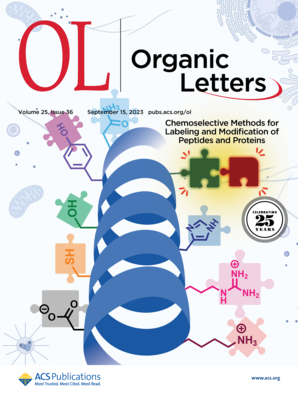AIE活性π共轭二吡啶-二吡罗乙烯选择性生物分析物识别。
IF 5
1区 化学
Q1 CHEMISTRY, ORGANIC
引用次数: 0
摘要
我们展示了一种双态发光π共轭二吡啶-二吡啶发色团(6)的设计和光物理性质,该发色团是通过(E)-二吡啶选择性二甲酰化,然后与2-氨基吡啶缩合而合成的。合理的分子设计,结合氢键和π··π相互作用,使该体系在固态中具有独特的超分子结构,并表现出聚集诱导发射的特性。我们进一步扩展了发色团6选择性检测血清白蛋白的适用性。本文章由计算机程序翻译,如有差异,请以英文原文为准。

AIE Active π-Conjugated Dipyridyl-Dipyrroethene for Selective Bioanalyte Recognition
We demonstrated the design and photophysical properties of a dual-state emissive π-conjugated dipyridyl-dipyrroethene chromophore (6) synthesized via selective diformylation of (E)-dipyrroethene followed by condensation with 2-amino pyridine. The rational molecular design, incorporating both hydrogen bonding and π···π interactions, leads to a unique supramolecular architecture in the solid state, and the system exhibits aggregation-induced emission properties. We further extend the applicability of chromophore 6 for the selective detection of serum albumin.
求助全文
通过发布文献求助,成功后即可免费获取论文全文。
去求助
来源期刊

Organic Letters
化学-有机化学
CiteScore
9.30
自引率
11.50%
发文量
1607
审稿时长
1.5 months
期刊介绍:
Organic Letters invites original reports of fundamental research in all branches of the theory and practice of organic, physical organic, organometallic,medicinal, and bioorganic chemistry. Organic Letters provides rapid disclosure of the key elements of significant studies that are of interest to a large portion of the organic community. In selecting manuscripts for publication, the Editors place emphasis on the originality, quality and wide interest of the work. Authors should provide enough background information to place the new disclosure in context and to justify the rapid publication format. Back-to-back Letters will be considered. Full details should be reserved for an Article, which should appear in due course.
 求助内容:
求助内容: 应助结果提醒方式:
应助结果提醒方式:


